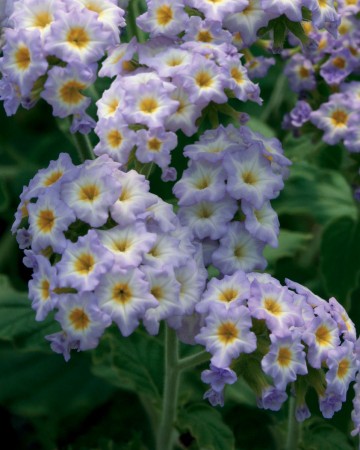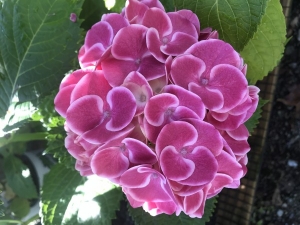
Our first stop was the Hope Hill Lavender farm. Located in Pottsville in Schuylkill County, Hope Hill sits atop a scenic rise with over 4,000 lavender plants growing in rows radiating downhill. Formerly a Christmas tree farm, and abutting a state forest, this farm has been growing lavender for about 10 years. Wendy Jochems and her husband Troy chose to grow lavender due to its relative resistance to deer, insects and disease- making it an ideal choice for organic farming methods.
They grow a combination of both French lavender, Lavendula x intermedia, and English lavender, Lavendula angustifolia. Like many herbs, lavender is in the mint family characterized by square stems, and aromatic foliage. Its tubular flowers attract a plethora of bees and other pollinators. It grows best in full sun and very well drained soil. A neutral or “sweet” soil with pH in the range of 6-8 is best. If you can grow acid-loving blueberries, azaleas and rhododendrons with ease, you will probably be unsuccessful with lavender unless you add lime to raise the pH.
In general, French lavender is larger with longer leaves, taller flower spikes and a higher camphor content which makes it more aromatic. These flowers are harvested for their oils which are steam-distilled from the buds to make lotions and soaps. Their longer stems also make nice dried bouquets and sachets. You may be familiar with the popular cultivars ‘Grosso’ or ‘Phenomenal’ French lavender.
English lavender is shorter with more vibrant flower colors. Popular English lavender selections are ‘Hidecote’, ‘Munstead’ and ‘Melissa’. The fragrance is sweeter, making it the choice of chefs and bakers for culinary use. I sampled my first lavender cookies and lavender tea and was pleasantly surprised. English lavender is often dried for bouquets as its more intense flower color holds up well in everlasting arrangements.
Wendy gave us some great pruning tips. The first year remove all the flowers even though it may pain you. Lavender is a woody sub-shrub and you want to direct its energy to developing strong roots and a good branching system. The second year as it comes out of dormancy, cut it back to 4-5 inches tall in a nice mound shape. Lavender is late to leaf out. Don’t panic if you don’t see green immediately. Depending on how cold the winter was, it may take until the end of May to break dormancy. Lightly trim it to enhance branching and keep it in a mounded shape. The third season it should reach mature size. A light trim is all that is required at this stage.
To dry lavender stems for crafting or culinary use, remove the stems just as the buds are beginning to open. Tie 20-50 stems together with rubber band or string and hang them upside down in a dry, dark, warm area. Wendy’s drying shed had five box fans blowing across her bundles but when I did it as a girl, I hung a string in my mother’s sewing room where there was a good breeze as the windows were usually open in those pre-AC days. It takes a few weeks to dry completely.
This last year was a rough one for lavender. With record rainfall in 2018, going into the winter with saturated soil sounded a death knell to many lavender plants. Wendy told me her farm lost many of their mature French lavenders and she was not alone. The lavender farm we were to visit originally cancelled our tour as they had a total loss and had to replant completely. English lavender seems to withstand rainfall on the foliage and damp soil better, but the more robust French tolerates heat and humidity more successfully. Here in PA, it’s a toss-up which we have more of.
I’ll be back to visit Wendy and Hope Hill Farm again. They are open Saturdays in the spring and more during high season in July when the lavender is in full bloom. They make and sell soaps, oils, and other lovely gifts. Crafting and culinary classes incorporating lavender are also a draw as well as their three donkeys. They also keep bees and sell the honey. She actively manages their facebook page and website hopehilllavenderfarm.com. The afternoon adventures to Fonthill Castle and the Mercer Museum in Bucks County were places I would not have ventured to on my own, but made for a fun day of family fellowship.
 In addition to being beautiful places to visit, our public botanic gardens have strong research arms. Mt. Cuba trials cultivars of our native species, most recently Phlox, Monarda, Heuchera, oakleaf and snowball Hydrangea. Longwood does plant exploration and has a breeding program in addition to trialing annuals. In the Midwest, the Chicago Botanic garden has been trialing perennials under the watchful eye of Richard Hawke for the last 30 years. Most recently he published a review of ferns two groups of ferns.
In addition to being beautiful places to visit, our public botanic gardens have strong research arms. Mt. Cuba trials cultivars of our native species, most recently Phlox, Monarda, Heuchera, oakleaf and snowball Hydrangea. Longwood does plant exploration and has a breeding program in addition to trialing annuals. In the Midwest, the Chicago Botanic garden has been trialing perennials under the watchful eye of Richard Hawke for the last 30 years. Most recently he published a review of ferns two groups of ferns. What is the first thing you do when someone gives you flowers? If you are like most people, you lift them to your nose and sniff. Our brains tell us flowers SHOULD be fragrant. Unfortunately, most are no longer. Bred for large size and diverse colors, fragrance seems to be an afterthought. If you want to add back fragrance to your yard here are my Top 20 Fragrant Plants.
What is the first thing you do when someone gives you flowers? If you are like most people, you lift them to your nose and sniff. Our brains tell us flowers SHOULD be fragrant. Unfortunately, most are no longer. Bred for large size and diverse colors, fragrance seems to be an afterthought. If you want to add back fragrance to your yard here are my Top 20 Fragrant Plants. Last week’s article tacked the question of growing edibles in containers. Today’s popular query seems to be why is my (fill in the blank) not blooming?
Last week’s article tacked the question of growing edibles in containers. Today’s popular query seems to be why is my (fill in the blank) not blooming?